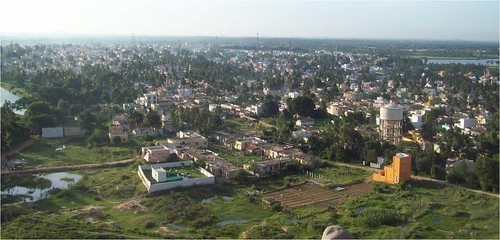/topics/health
Health
Lets paint our cities green ! - Issues of collective effort come to the fore at the organic urban gardening conference in Chennai
Posted on 06 Mar, 2013 10:25 AMThe maddening pace of cities have the potential to drive one up the wall. But, there are options - to unwind and to mend the disconnect. Tending to plants is a popular hobby and it is a fact that a sizeable number of city dwellers have taken to gardening in the past, finding solace in twines and tendrils.
An evaluative study on the informal water distribution system in Kaula Bandar slum in Mumbai- A paper in BioMed Central Public Health Journal
Posted on 03 Mar, 2013 07:22 PMAs a result of rapid urbanisation, majority of migrated population is forced to settle in places which are not legally recognised by state authorities. These areas thus lack in basic services like water supply and sewerage. Consequently, the slum dwellers often resort to illegal methods to avail these services.
Anthropogenic activities leads to deterioration of groundwater quality: A study of Mayyanad and Edamulakkal panchayats of Kollam district in Kerala
Posted on 22 Feb, 2013 10:07 AMKerala is a rain blessed state in the country. It has highest number of wells, when compared with other states. However due to its slanting topography there is significant decline in the ground water levels leading to severe water scarcity during summer months in most districts of the state. Further over extraction and dependence of groundwater for domestic use from the dug wells especially in rural pockets has resulted in several groundwater problems. In this backdrop the paper in The Ecosan- An International Quarterly Journal of Environmental Science, sheds light on groundwater quality issues in two panchayats of Kerala.
Some strategies for managing groundwater by Aditi Mukherji, IWMI
Posted on 22 Feb, 2013 09:53 AMGroundwater is essential for India's agricutural economy. However, there is a large variation in the groundwater resources of each region. Some regions are already over-exploited, while others can still tolerate more withdrawal. In her blog 'Waterscapes', Aditi Mukherji discusses the need for regional strategies to manage groundwater economy.
Dealing with arsenic in rural Bihar - Evaluating the successes and failures of mitigation projects
Posted on 21 Feb, 2013 11:51 PMArticle Courtesy: Delft University of Technology
Author(s): Matthijs Brouns, Merijn Janssen, Andrew Wong
Video documentary on the work done by Dr. Sudarshan for the upliftment of Soliga tribes in BR Hills, Karnataka- A webisode in Chai with Lakshmi
Posted on 20 Feb, 2013 11:47 AMSource of video: Chai with Lakshmi
Assessing the land use change and its impact on water resources: A study on the Mula and Mutha rivers catchment area in Pune
Posted on 17 Feb, 2013 09:11 PMLand use changes hydrologic system and have potentially large impacts on water resources. An assessment in an area with seasonally limited water availability and which is subject to rapid socio- economic development and population growth will provide an exemplary view on the local impacts of major recent developments in India. In this backdrop this paper analyzes past land use changes between 1989 and 2009 and their impacts on the water balance in the Mula and Mutha Rivers catchment upstream of Pune. The aim of the paper is:
- assess the land use changes between 1989/1990 and 2009/2010
- analyze the impacts of these changes on the long-term water balance components in the Mula and Mutha Rivers catchment upstream of the city of Pune.
The role of sanitation in girl child education - A documentary film by HEEALS
Posted on 15 Feb, 2013 08:31 PM
The role of sanitation in girl child education - A documentary film by HEEALS
HEEALS is a vibrant civil society organization that aims to safeguard health, environment, education and livelihood to promote sustainable development of society. Through the medium of documentary film and art it is trying to create awareness among the masses about girl child education, menstrual hygiene, sanitation and safe drinking water and attempting to relate how girl child education directly suffers due to bad sanitation facilities, unsafe drinking water and lack of knowledge to obtain the same.
Influence of anthropogenic contamination on fluoride concentration in groundwater: A study of Mulbagal town, Kolar district, Karnataka
Posted on 15 Feb, 2013 04:53 PMGroundwater contamination is a serious, but relatively ignored issue in the country. This contamination occurs in either through geogenic or anthropogenic means. Fluoride contamination is one such example of geogenic contamination that is widely found in the Kolar district of Karnataka. However, the fluoride levels in the town of Mulbagal are lower than those in the surroundings. Earlier, a study was conducted on the impact of pit toilets on the groundwater in the area. The present paper investigates the presence of any link between these two phenomena.
Assessment of exposure, intake and toxicity of fluoride from groundwater sources in Unnao district of Uttar Pradesh
Posted on 28 Jan, 2013 01:40 PMFluoride is one of the most commonly found elements in the earth’s crust. It is naturally found d in water and helps in healthy tooth development and cavity prevention. However its high concentration in water can be harmful to human health. The amount of Fluoride (F) occurring naturally in groundwater is governed principally by climate, composition of the host rock, and hydrogeology. As per the World Health Organization and Indian Council of Medical Research the permissible limit to fluoride in drinking water is 1.5mg/L. Anything more than this value can cause fluorosis (dental and skeletal), which can affect the bones and teeth. In the backdrop of this aspect of water quality, this paper in RASĀYAN Journal of Chemistry, tries to assess the exposure to fluoride through drinking water consumption and to elucidate fluoride endemic areas through mapping in Unnao district of Uttar Pradesh.





